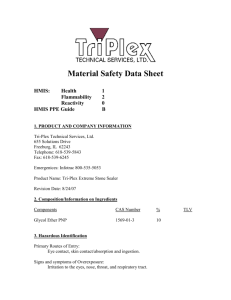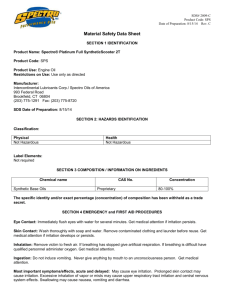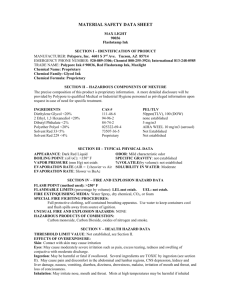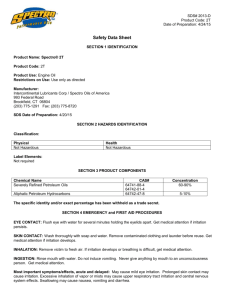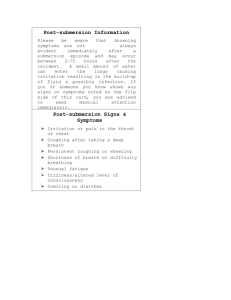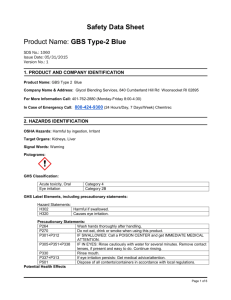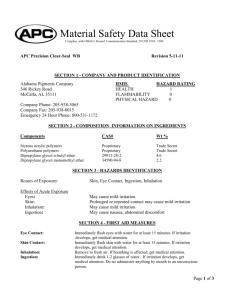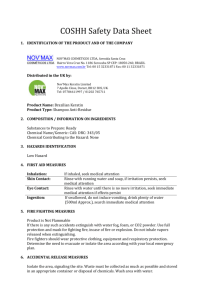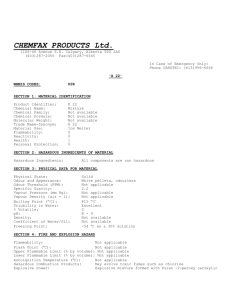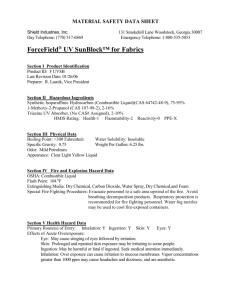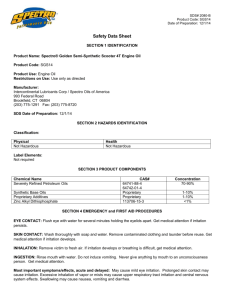70-90% - Spectro Oils
advertisement
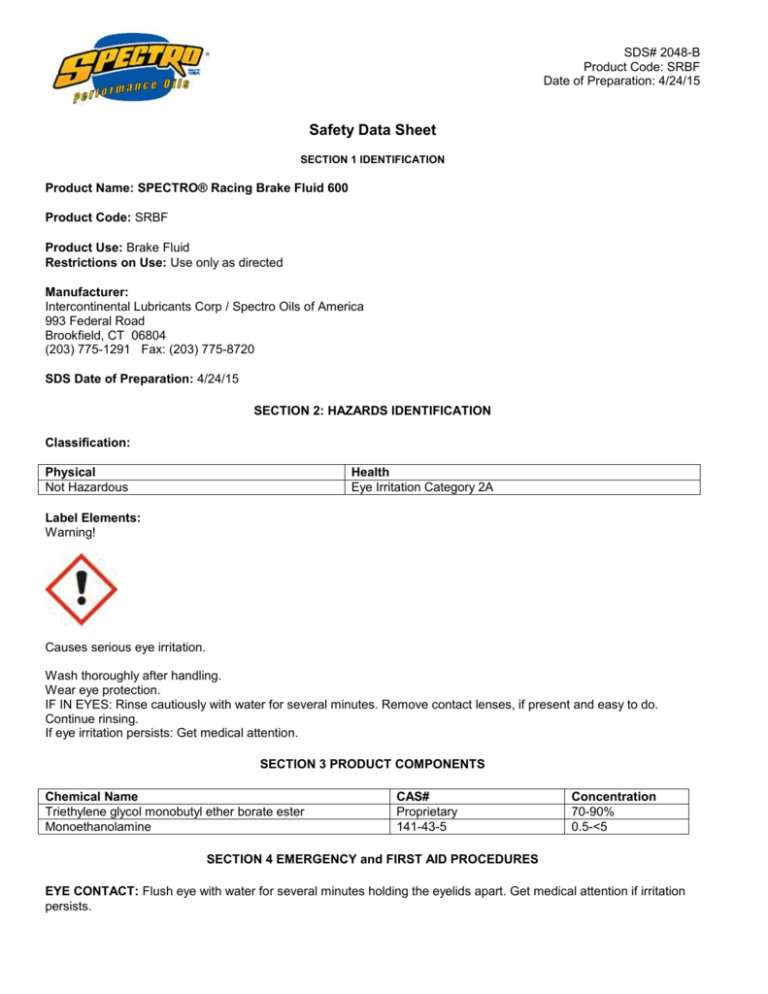
SDS# 2048-B Product Code: SRBF Date of Preparation: 4/24/15 Safety Data Sheet SECTION 1 IDENTIFICATION Product Name: SPECTRO® Racing Brake Fluid 600 Product Code: SRBF Product Use: Brake Fluid Restrictions on Use: Use only as directed Manufacturer: Intercontinental Lubricants Corp / Spectro Oils of America 993 Federal Road Brookfield, CT 06804 (203) 775-1291 Fax: (203) 775-8720 SDS Date of Preparation: 4/24/15 SECTION 2: HAZARDS IDENTIFICATION Classification: Physical Not Hazardous Health Eye Irritation Category 2A Label Elements: Warning! Causes serious eye irritation. Wash thoroughly after handling. Wear eye protection. IF IN EYES: Rinse cautiously with water for several minutes. Remove contact lenses, if present and easy to do. Continue rinsing. If eye irritation persists: Get medical attention. SECTION 3 PRODUCT COMPONENTS Chemical Name Triethylene glycol monobutyl ether borate ester Monoethanolamine CAS# Proprietary 141-43-5 Concentration 70-90% 0.5-<5 SECTION 4 EMERGENCY and FIRST AID PROCEDURES EYE CONTACT: Flush eye with water for several minutes holding the eyelids apart. Get medical attention if irritation persists. SDS# 2048-E Product Code: SRBF Date of Preparation: 04/24/15 SKIN CONTACT: Wash thoroughly with soap and water. Remove contaminated clothing and launder before reuse. Get medical attention if irritation develops. INHALATION: Remove victim to fresh air. If irritation develops or breathing is difficult, get medical attention. INGESTION: Rinse mouth with water. Do not induce vomiting. Never give anything by mouth to an unconsciousness person. Get medical attention. Most important symptoms/effects, acute and delayed: Causes eye irritation. Prolonged skin contact may cause irritation. Excessive inhalation of vapor or mists may cause upper respiratory tract irritation. Swallowing may cause nausea, vomiting and diarrhea. Indication of immediate medical attention and special treatment, if necessary: None required under normal conditions of use. SECTION 5 FIRE and EXPLOSION HAZARD DATA Suitable extinguishing media: Use water fog, foam, carbon dioxide or dry chemical to extinguish. Do not use a direct water stream. Specific hazards arising from the chemical: Not classified as a combustible liquid but will burn under fire conditions. At elevated temperatures containers may rupture. Use of large amounts of water may cause product to float and spread fire. Combustion may produce carbon and nitrogen oxides. . Special protective equipment and precautions for fire-fighters: Firefighters should wear full emergency equipment and a NIOSH approved positive pressure self-contained breathing apparatus. Cool exposed intact containers with water spray or stream. SECTION 6 ACCIDENTAL RELEASE MEASURES Personal precautions, protective equipment, and emergency procedures: Wear appropriate protective equipment. Wash thoroughly after handling. Environmental hazards: Avoid release into the environment. Report spill as required by local and federal regulations. Methods and materials for containment and cleaning up: Dike spill and collect with an inert absorbent and place into closable containers for disposal. SECTION 7 HANDLING and STORAGE Precautions for safe handling: Avoid contact with eyes, skin and clothing. Avoid breathing vapors and mists. Wash thoroughly after handling. Remove contaminated clothing and launder before re-use. Empty containers retain product residues. Do not cut, weld, braze, etc. on or near empty containers. Follow all SDS precautions in handling empty containers. Spills on fibrous insulation may lower the autoignition temperatures resulting in spontaneous combustion. Conditions for safe storage, including any incompatibilities: Protect containers from physical damage. Store in a cool area away from oxidizers and other incompatible materials. Store in original containers. Do not store in aluminum, copper, galvanized iron or galvanized steel. Page 2 of 5 SDS# 2048-E Product Code: SRBF Date of Preparation: 04/24/15 SECTION 8 EXPOSURE CONTROLS and PERSONAL PROTECTION Exposure Guidelines: Chemical Name Triethylene glycol monobutyl ether borate ester Monoethanolamine CAS#. Proprietary Exposure Limits 2 mg/m3 TWA (inhalable), 6 mg/m3 STEL (inhalable) ACGIH TLV (as borate compounds) 3 ppm TWA OSHA PEL 3 ppm TWA, 6 ppm STEL ACGIH TLV 141-43-5 Appropriate engineering controls: Good general room ventilation (equivalent to outdoors) should be adequate under normal conditions. . If exposures limits are exceeded, increased mechanical ventilation such as local exhaust may be required. Respiratory protection: None needed under normal use conditions with adequate ventilation. If exposures are excessive, use a NIOSH approved respirator with organic vapor cartridges and particulate pre-filter. Selection of respiratory protection depends on the contaminant type, form and concentration. Select in accordance with OSHA 1910.134 and good Industrial Hygiene practice. Skin protection: Chemical resistant gloves such as butyl rubber or Ethyl Vinyl Alcohol Laminate (EVAL) are recommended where prolonged or repeated skin contact is likely. Eye protection: Safety glasses or goggles if splashing is possible. Other: Impervious apron, boots and other clothing are recommended if needed to avoid prolonged/repeated skin contact. Suitable washing facilities should be available. SECTION 9 PHYSICAL and CHEMICAL PROPERTIES Appearance (physical state, color, etc.): Colorless to yellow liquid Odor: Ether odor. Odor threshold: Not available Freezing point/Pourpoint: Not available Flash point: 294°F / 146.1°C CC Flammability (solid, gas): Not applicable Flammable limits: LEL: Not available Vapor pressure: <0.01 mmHg@ 20°C Relative density: 1.08 Partition coefficient: n-octanol/water: Not available Decomposition temperature: Not available pH: 7.2 Boiling Point: >394°F / >201°C Viscosity: 1698@ 40°C UEL: Not available Vapor density (air =1): 10 Solubility(ies): Not available Auto-ignition temperature: Not available Evaporation rate: Not available SECTION 10 STABILITY and REACTIVITY Reactivity: This product is not expected to react. Chemical stability: The product is stable. Possibility of hazardous reactions: None known. Conditions to avoid: Avoid excessive heat. Product can oxidize at elevated temperatures. Incompatible materials: Avoid strong oxidizing agents, acids and bases. Hazardous decomposition products: Thermal decomposition may yield carbon and nitrogen oxides, aldehydes, alcohols and organic acids Page 3 of 5 SDS# 2048-E Product Code: SRBF Date of Preparation: 04/24/15 SECTION 11 TOXICOLOGICAL INFORMATION Health Hazards: Inhalation: Excessive inhalation of vapors or mists may cause upper respiratory tract irritation and central nervous system effects including headache, dizziness and nausea. Breathing high concentrations of oil mists may cause lipid pneumonia. Skin Contact: Prolonged or repeated contact may cause mild irritation or dryness. Repeated skin contact may cause dermatitis. Eye Contact: May cause mild irritation. Ingestion: Swallowing large amounts may cause gastrointestinal effects including nausea and diarrhea. Chronic Effects of Overexposure: None known. Sensitization: None of the components have been found to cause sensitization in animals or humans. Mutagenicity: This product is not expected to cause mutagenic activity. Reproductive Toxicity: This product contains a chemical that cause birth defects in animals only at doses that were toxic to the mother. Carcinogenicity: None of the components of this product are listed as a carcinogen or suspected carcinogen by IARC, NTP or OSHA. ACUTE TOXICITY VALUES: Triethylene glycol monobutyl ether borate ester: Oral rat LD50 11,800 mg/kg, Dermal rabbit LD50 7400 mg/kg Monoethanolamide: Oral rat LD50 1515/kg, Dermal rabbit LD50 2054 mg/kg SECTION 12: ECOLOGICAL INFORMATION Ecotoxicity: Triethylene glycol monobutyl ether borate ester: 96 hr LC50 Oncorhynchus mykiss 590 mg/L, 48 hr EC50 daphnia magna >1000 mg/L Monoethanolamide: 96 hr LC50 Cyprinus carpio 349 mg/L, 48 hr EC50 daphnia magna 65 mg/L, 72 hr EC50 Pseudokirchnerella subcapitata 2.8 mg/L Persistence and degradability: The product is not readily biodegradable. Bioaccumulative potential: Not expected to bioaccumulate. Mobility in soil: No data available. Other adverse effects: None known. SECTION 13: DISPOSAL INFORMATION WASTE DISPOSAL METHOD: Dispose in accordance with all local, state and federal regulations. Page 4 of 5 SDS# 2048-E Product Code: SRBF Date of Preparation: 04/24/15 SECTION 14: TRANSPORTATION INFORMATION UN Number Proper shipping name Hazard Class Packing Group Environmental Hazard Not Regulated Not Regulated Not Regulated Not Regulated DOT TDG IMDG IATA Transport in bulk (according to Annex II of MARPOL 73/78 and the IBC Code): Not applicable – product is transported only in packaged form. Special precautions: None known. SECTION 15: REGULATORY INFORMATION Safety, health, and environmental regulations specific for the product in question. CERCLA: This product is not subject to CERCLA reporting requirements. Many states have more stringent release reporting requirements. Report spills required under federal, state and local regulations. EPA SARA 302: This product does not contain chemicals regulated under SARA Section 302. EPA SARA 311 HAZARD CLASSIFICATION: Acute Health. EPA SARA 313: This product contains the following chemicals that are regulated under SARA Title III, section 313: Triethylene glycol monomethyl ether 112-35-6 70-90% CALIFORNIA PROPOSITION 65: This product contains chemicals known to the State of California to cause cancer and reproductive toxicity. TOXIC SUBSTANCES CONTROL ACT: All of the components of this product are listed on the TSCA inventory. Canada CEPA: All of the components of this product are listed on the Canadian Domestic Substances List. European EINECS: All of the components of this product are listed on the EINECS inventory. SECTION 16: OTHER INFORMATION NFPA Rating: Health: 1 Fire: 1 Reactivity: 0 Revision History: 04/24/15: Converted to GHS format. All section revised Page 5 of 5
